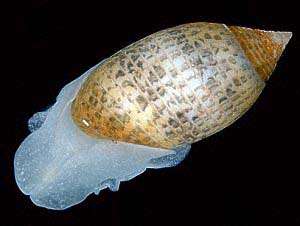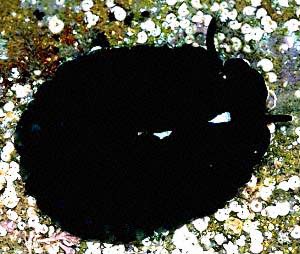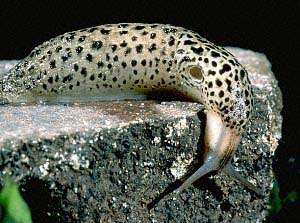
What is a slug?
PHOTO
UPPER:
Pupa sulcata, an opisthobranch sea slug, New Caledonia, October 1993.
LOWER RIGHT: Limax maximus, a pulmonate land slug, Sydney garden.
LOWER LEFT: Scutus antipodes, the "prosobranch" elephant slug, Sydney.
PHOTOS: Bill Rudman.
RELATED TOPIC
Detorsion - how snails became sea slugs
All these animals are called slugs. The word "slug" describes a body shape rather than a group of species with a common ancestor. Essentially, "slugs" are "snails" that have either lost their shells or are in the process of losing their shells. This has happened many times in snail evolution. The most obvious "slug groups" are the the sea slugs and the land slugs.
The sea slugs (ORDER Opisthobranchia) contain not only the spectacular nudibranchs, which have all lost their shells, but also primitive groups such as the Cephalaspidea or Bubble Shells which have snail-like members with heavy external shells (Pupa sulcata) as well as members with brightly coloured bodies and no shell (Sagaminopteron ornatum ).
The land snails (ORDER Pulmonata) have on a number of separate occasions evolved "slugs". One common northern hemisphere family, the Limacidae, have cursed most of the temperate world with pests such as Limax maximus. The name "pulmonata" refers to their development of the mantle cavity into a lung for airbreathing. The large hole visible in the accompanying photo below, is the pore (pneumostome) through which air moves in and out of the lung.
The marine snails (previously ORDER Prosobranchia)are no longer considered to be a single group with a common phylogenetic ancestry. Amongst these animals, slugs have evolved many times. The Australian Elephant Slug, Scutus, in fact retains a shield like shell (white streak in photo) which is hidden beneath flaps of skin.
LOWER RIGHT: Limax maximus, a pulmonate land slug, Sydney garden.
LOWER LEFT: Scutus antipodes, the "prosobranch" elephant slug, Sydney.


Rudman, W.B., 1998 (October 26) What is a slug?. [In] Sea Slug Forum. Australian Museum, Sydney. Available from http://www.seaslugforum.net/find/nonslug
Related messages
Nudibranch Evolution
March 7, 2006
From: Valerie Burkholder
I am doing a project on nudibranchs and I am curious about their evolution. Did nudibranchs and land slugs evolve together and then diverge, or did they evolve simultaneously but then diverge?
Valerie Burkholder
valiburkholder@gmail.com
Burkholder, V.M., 2006 (Mar 7) Nudibranch Evolution. [Message in] Sea Slug Forum. Australian Museum, Sydney. Available from http://www.seaslugforum.net/find/16017Dear Valerie,
I can give you a small answer to a very big question. Firstly I can't really see the difference in the two alternatives you ask about - to diverge they would need first to be together.
The important first thing to realise is that a 'slug' is a body shape or 'grade' of organisation not an evolutionary group. For example sharks, bony fish, dolphins are all 'fish' in the sense that they all have a fish grade of organisation, but they are not closely related to each other in evolutionary terms. The slug shape has independently evolved many times in the gastropod molluscs from shelled snails. Have a look at the 'What is a slug ?' Fact Sheet. We still have much to learn about the evolution of gastropods, but the general consensus at present is that the Opisthobranchs and Pulmonates - that is the animals that make up the sea slugs and the land snails (& slugs) - have a common ancestry, being descended from a special group of marine snails with peculiarities in their nervous system, larval shell, radula and mantle cavity, which set them apart from all other marine snails.
So what we can say is that sea slugs and land slugs have a common ancestor, but the huge diversity we see today is the result of many evolutionary events which include the independent development of the slug form many times.
Best wishes,
Bill Rudman
What is a slug?
September 16, 2005
From: Steven Mcconnachie
After reading a passage in the Bill Bryson book A short history of everything, I was lead to believe that slugs were a form of plant life, cells that had combined and formed a slug, is this true? Don't know species or region.
Steven Mcconnachie
stevencnx@ aol.com
Mcconnachie, S., 2005 (Sep 16) What is a slug?. [Message in] Sea Slug Forum. Australian Museum, Sydney. Available from http://www.seaslugforum.net/find/14781Dear Steev,
I have been meaning to read that book but have yet to find time so I'll make a guess at what he was talking about. I suspect he was referring to Slime Moulds [Slime Molds] which are a group of primitive organisms that used to be considered Fungi, but are now placed in the Kingdom Protista. One group of these, the cellular slime moulds, spend much of their life as single cells, but they have this amazing ability to aggregate together - when they get the urge - to form a 'slug' which can crawl along. The slug usually forms into a reproductive body, often raising itself from the substrate to form a little fruiting body.
Here are a couple of websites with information. The second one has some fascinating short movies.
http://www.hiddenforest.co.nz/slime/index.htm
http://cosmos.bot.kyoto-u.ac.jp/csm/movies.html
Are they 'slugs'? The term slug usually refers to the relatives of snails, both on land and in the sea, which have lost their shells during their evolution. However, as is the way with most common terms, 'slug' is widely used to mean any slug-like organism.
Best wishes,
Bill Rudman
Sea Slugs with shells?
May 7, 2002
From: Amanda
Dear Dr. Rudman,
I was wondering, can sea slugs really have shells?
Amanda
user@domain.name
Amanda, 2002 (May 7) Sea Slugs with shells?. [Message in] Sea Slug Forum. Australian Museum, Sydney. Available from http://www.seaslugforum.net/find/6897Dear Amanda,
Have a look at the page on how snails became slugs. It will give you links to other relevant pages. The basic point is that 'slugs' have evolved many times from snails through the gradual downgrading in importance of the external shell, until finally the shell is completely lost in the adult, although often still present in the larvae. Of all the sea slug groups, it is only in the nudibranchs that the shell is absent in all adults. In other groups, such as the cephalaspidean 'Bubble-shells', such as Pupa coccinata, an external shell is often present, while in the sacoglossans, we have a continuum from animals with an external shell, such as Volvatella ayakii to 'nudibranch'-like species, such as Stiliger smaragdinus, in which there is no trace of a shell.
Best wishes,
Bill Rudman
Is sea slug a fish?
April 15, 2002
From: Stephaine
Dear Mr Rudman,
I wish to know whether a sea slug is a fish.
Stephaine
coolgirlz@asia1.com.sg
Stephaine, 2002 (Apr 15) Is sea slug a fish?. [Message in] Sea Slug Forum. Australian Museum, Sydney. Available from http://www.seaslugforum.net/find/6745Dear Stephaine,
Sea Slugs are specialised snails, and many of them, such as the nudibranchs, have 'lost' their shells. If you go to the What is a Slug? page you will find some information and links to other pages which discuss this topic.
Snails are molluscs, a Phylum of animals that also includes squid, octopus, and clams. Fish on the other hand are chordates (including vertebrates), a Phylum which includes all animals with a backbone - fish, frogs, birds, mammals etc.
Best wishes,
Bill Rudman
Sea slug from Indiana?
November 23, 1999
From: LV
Okay, this obviously has nothing to do with sea slugs, but it is a slug...i think. I live in Indiana. This evening I noticed a large slug on my front door. It is about 3-4 inches long, and and tan body with black stripes. The head is also tan colored, but had black spots. I find it unusual to see it considering the chilly 40F outside!
Can you please tell me a little more about this creature?
Thanks,
LV
lvander2@purdue.edu
Dear LV,
I really can't deal with snails and slugs worldwide but from your description I suspect you may have Limax maximus of which there is a photo on the "what isn't a sea slug" page.
Often the back half of the body has stripes rather than spots. We call it the Leopard Slug in Australia. It is a European species which has been introduced to many parts of the world. It is more of a carnivore than a herbivore, preferring cat and dog food, to more natural foods.
If your slug doesn't look like the photo then I suggest you try your local museum. As much as I admire your attitude, I really haven't the time, or the knowledge, to take on all the world's molluscs.
Best wishes,
Bill Rudman.
Scientific Name for a slug?
October 26, 1998
From: Jaykada McFadden
What is the scientific name for a slug?
Jaykada McFadden
jkmcfadden@aol.com
McFadden, J., 1998 (Oct 26) Scientific Name for a slug?. [Message in] Sea Slug Forum. Australian Museum, Sydney. Available from http://www.seaslugforum.net/find/276Dear Jaykada,
I'm afraid there is not a scientific name for a slug. Have a look at the pictures and my comments at the top of this page.
Essentially a "slug" is a snail that has lost its shell, not through carelessness, but in an evolutionary process that has occurred many times amongst the gastropod molluscs. Both in the opisthobranch sea slugs and the pulmonate land snails there are many quite unrelated families and superfamilies which have independently begun the process of "losing the shell". Gradually the shell becomes smaller, and less heavily calcified until its reaches the stage where it no longer can protect the animal from attack or from environmental problems such as drying out.
At this stage the animal has to evolve other means of defence. Land slugs produce heavy mucus from their skins to prevent desiccation (drying out) and they are often well camouflaged, perhaps as a protection from attack. Most also become nocturnal, as they are less likely to be seen by predators or dry out at night. The many different ways opisthobranchs have evolved to protect themselves can be found in the Sea Slug Forum. Have a look at Opisthobranch Defence Mechanisms.
Bill Rudman.
